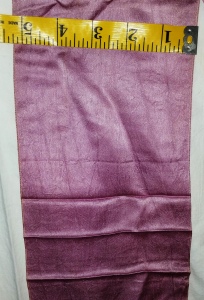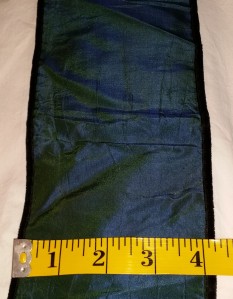This past summer, Kelly was incredibly lucky to find a beautiful assortment of ribbons in a suitcase. She was at a ‘junk’ sale in search of a tablecloth when she happened upon a suitcase which she bought unopened. Getting it home, she discovered it was full of ribbons, many lengths in pairs suggesting their use for millinery. These ribbons appear to be untouched for decades and in pretty decent shape.
Kelly shared full length photo with me. I’m sharing close-up photos so we can focus on the qualities of each. That said, there are a few that I don’t know what they are exactly.
These first three ribbons are taffeta. The deep blue taffeta appears as if the selvage edge may have a tiny satin weave.
Here we have a variation we see in a taffeta weave. We often use the word ombre. For ribbons, the techniques were the watered or clouded effect. These two techniques are different ways of developing the color of ribbon.
Clouding – A coloring technique used to vary the color in a ribbon. This coloring technique takes place at the thread dying stage. “The silk, already warped, is tied up and wound closely round with packthread at regular intervals of more or less than an inch, so that the intermediate spaces only are penetrated by the dye.”
Watered or Watering – A coloring technique where a pair of woven ribbons is passed between two rollers. One of the rollers is heated creating irregular pressure as the ribbons are pressed against each other. This produces a wavy appearance in the coloring. The ribbon can also be wet when passed through the rollers. “The air in trying to effect its escape, drives before it the moisture, and hence causes the appearance of the curiously tortuous lines, resembling waves. (Cole, George S.. A Complete Dictionary of Dry Goods and History of Silk, Cotton, Linen, Wool and other Fibrous Substances. Chicago: W. B. Conney,1892)
This is another taffeta ribbon, a shot taffeta, with velvet stripes along each edge. Mixing weaves was not unusual in 19th century ribbons. We often see satin stripes in taffeta ribbons.
Shot – A ribbon with variation in colouring where the warp and weft are different colors.
Occasionally, I hear people ask about sheer ribbons. Yes, they did have sheer ribbons in the 19th century. Kelly has two examples that demonstrate how these ribbons were sheer but still had a firm body.
Gauze – Transparent ribbons made with a fine hard-twisted silk thread called marabout woven in a plain weave. Finer gauzes have over 80 threads per inch. “The plain gauze ribbons made at Coventry called China gauzes are chiefly those used for mourning – white, black and lavender, with satin or ground stripes.” (see http://www.met.org # C.I.38.23.167)
Floret Gauzes and Taffeties – Light ribbons made with organzine warp and marabout weft. In other words, the warp of a sarsenet ribbon and the weft of a gauze ribbon.
Kelly has s nice example of a cream damask with a pretty rose design. Notice how the roses are spaced.
Damask – Ribbons with woven designs. These can be geometrical or floral frequently using combinations of leaves, sprigs and flowers. “In superior French ribbons groups and wreathes of flowers are executed with the richness and variety of hand-embroidery. The French are continually introducing novelties in colouring and in texture. In one of recent appearance the ribbon is laid over with a slight covering like crape, by means of a warp of hard-silk woven in loosely over the other; in another ribbon is made by stamping to assume the appearance of lace.”
Kelly had some mystery ribbons. First is this woven design that really reads newer to me. But, if it is newer, why was it in this set?
The next mysterious ribbon that has peaked my curiosity is this green ribbon – It may have been put through a crimper. But, if it was a crimper, wouldn’t that satin selvage be crimped too???










